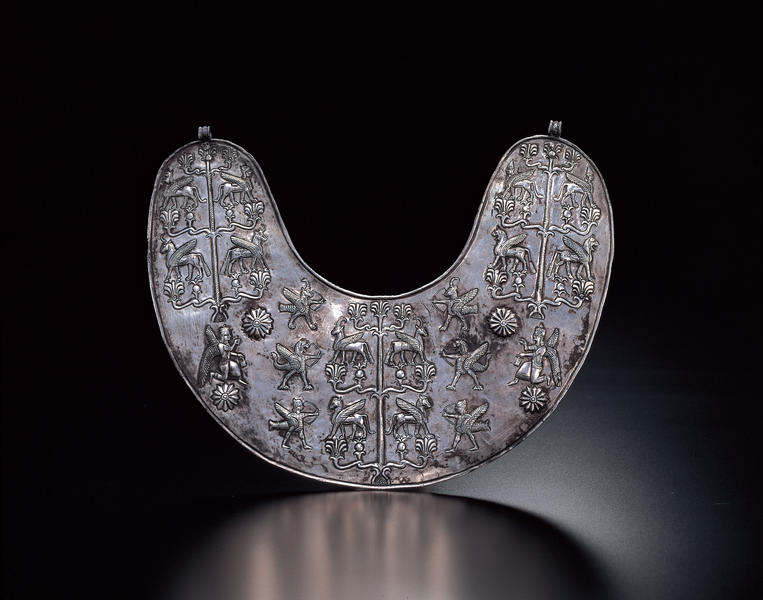ペクトラル(胸飾)
- アナトリア東北部
- ウラルトゥ王国
- 前8-前7世紀
- 銀
- H-14.2 W-18.4
その意匠はほぼ左右対称に生命の樹と有翼の霊獣や精霊が多く配され、毬果とシトゥラを持って清めの仕草をする精霊も見られる。これらの要素は紀元前二千年紀以来のメソポタミアやアナトリアの流れを汲むがウラルトゥ特有の雰囲気を持つ。アッシリアやウラルトゥの遺物にはこのペクトラルをつけた人物や精霊の表現が見られるが、これと類似の胸飾はウラルトゥの前身であるヒッタイトの時代にエジプトから伝えられたと想像され、護符的性格を強く持ったものであると言われている
文化的影響
ウラルトゥはヒッタイト帝国の要部を構成していたアナトリア高原の民族フリアンの建てた国で、銀、銅、鉄の資源が豊富であり、早くから金属工芸が栄えました。
フリアンは紀元前二千年紀ヒッタイト帝国の時代にエジプトと盛んな交渉があり、多くの影響を受けました。
ペクトラルの形態は何らかエジプトの胸飾を想わせるものがあり、東地中海岸ビュブロスからは紀元前二千年紀のエジプトの影響を直接受けたと思われるペクトラルが見つかっています。
また紀元前一千年紀初頭にはウラルトゥはギリシャや北イタリアのエトルリアとの交易を独占し、西アジアの要素をこの地中海域に積極的にもたらしました。
同じ頃ウラルトゥ及び北西イランをめぐる地域には更に北方からのイラン系スキタイの侵入が頻繁になるなど、多数の民族が入り乱れ、複雑な文化的融合を産み出して行きました。
北西イラン・ウルミア湖の南、ジヴィエからは薄い金板に精緻な文様の刻まれたペクトラルが発見されていますが、そこに表された動物はスキタイ様式であり、有翼牛の表現はアッシリア様式を踏襲しています。
ウラルトゥとその時代
ウラルトゥはヒッタイト帝国の要部を構成していたアナトリア高原(現在のトルコ付近)の民族フリアンの建てた国で、銀、銅、鉄の資源が豊富であり、早くから金属工芸が栄えました。
フリアンは紀元前二千年紀ヒッタイト帝国の時代にエジプトと盛んな交渉があり、多くの影響を受けました。ペクトラルの形態は何らかエジプトの胸飾を想わせるものがあり、東地中海岸ビュブロスからは紀元前二千年紀のエジプトの影響を直接受けたと思われるペクトラルが見つかっています。
また紀元前一千年紀初頭にはウラルトゥはギリシャや北イタリアのエトルリアとの交易を独占し、西アジアの要素をこの地中海域に積極的にもたらしました。
同じ頃ウラルトゥ及び北西イランをめぐる地域には更に北方からのイラン系スキタイの侵入が頻繁になるなど、多数の民族が入り乱れ、複雑な文化的融合を産み出して行きました。
北西イラン・ウルミア湖の南、ジヴィエからは薄い金板に精緻な文様の刻まれたペクトラルが発見されていますが、そこに表された動物はスキタイ様式であり、有翼牛の表現はアッシリア様式を踏襲しています。
意匠について
紀元前9世紀に、メソポタミアの北にウラルトゥ王国が興りました。それは紀元前二千年紀末に滅んだアナトリア半島のヒッタイト帝国の流れを汲むもので、アッシリアに対抗する有力な勢力となりました。
このペクトラル(胸飾)は半月型の形状の中にほぼ左右対象に生命の樹と有翼の靈獣や精霊が配されています。三つの枝付燭台の形状をした生命の樹は、その各々の枝に有翼獣をのせ、中央の樹の両脇に弓を引く有翼の、山羊魚、人魚、蠍型(?)の尾を持ったライオンなどが縦に配されています。
左右の樹の下には天体をあらわす上下のロゼッタ文に挟まれるような位置に精霊が跪き、シトゥラと毬果を持って清めの仕草をしています。生命の樹やこれらの魔物は紀元前二千年紀以来のメソポタミアの流れを汲んだものですが、ウラルトゥ特有の雰囲気をも持っています。
これらは守護の働きを託された図像であると思われます。アッシリアやウラルトゥの遺物にはこのペクトラルをつけた人物や精霊の表現が見られ、近似例とみなされる三日月型のペンダントには守護を願った願文が見つかっていますが、これは護符の性格を強く持つ装身具であったと考えられます。
護符としての記述が読み取れる三日月形のペンダントはKarmir-Blur(アララット山の北側) から出土しています。このペクトラルに見られるような特定の場面を指し示さない、ありがたい形象で構成される装飾は、青銅板などのウラルトゥ遺物に多々見られます。
この三日月形ペクトラルの両端には吊金具が上下二箇所リベット留され、その下のリベットのペクトラル表面に出た頭は、枝付燭台型の生命の樹の上端に付いたアカンサス形の中心部をなす半球形の意匠として適応されています。
・ed. E.A.Wallis Budge / Assyrian Sculptures in The British Museum / 1914 London Pls. XXIII-1(124549), XXX
・B. B. Piotrovskii / Urartu The Kingdom of Van and its Art / 1967 Evelyn Pls. II, 2, 12-b
・The Israel Museum , Jerusalem / Urartu / 1991 Jerusalem
Catalogue Entry
The kingdom of Urartu that had spread east and south from the region of Lake Van in what is now eastern Turkey was known above all as the center of a vigorous metalworking industry. It utilized bronze, iron, and to a lesser extent silver and gold. Its metal artifacts were exported to lands as far away as Italy.
This crescent-shaped silver pectoral may have been worn around the neck of a high official. It has been suggested that gold, silver, and bronze pectorals connoted degrees of official rank in Urartian society.1 Two bronze statuettes in the Vorderasiatisches Museum, Berlin, depict male figures with crescent-shaped pectorals.2 Two bronze winged sphinxes, one in the British Museum and one in the Hermitage Museum, are shown wearing similar ornaments.3 A small couchant sphinx on a bronze candelabrum bearing an inscription naming an Urartian king as its owner also wears one.4 It would appear that both humans and non-human supernatural beings could be represented with this type of pectoral in Urartian art.
This pectoral's imagery is complex, featuring three sacred trees, so called, inhabited by striding fantastic winged quadrupeds. Two identical rows of two-legged winged creatures approach the central tree with drawn bows while two winged genii kneel on opposite sides of the crescent between pairs of raised rosettes. These motifs are most likely amuletic in function. Urartian imagery such as that seen here is found mainly on metal articles of personal use and chariot fittings, and seems to favor repetitive arrangements of individual elements that cannot be easily related to one another.5 Thus, we cannot tell with certainty whether the creatures with drawn bows are protecting or attacking the central sacred tree, or whether they are simply placed symmetrically with no specific relation to it.
A magnificent gold pectoral from Ziwiye in northwest Iran, dated to the seventh century B.C., is thought to have been inspired by the Urartian type in both shape and decoration.6 Distinctive but possibly derivative pectorals in precious metals have been found in Etruscan tombs; and it has been suggested that this type of ornament passed from the Etruscans to the Roman army.7 Other possibly related lunate pectorals dated to the mid-first millennium B.C. have been found in Eastern Europe.8 Also worth mentioning is a superb gold openwork crescent pectoral in the State Historical Museum in Kiev, clearly Greek in its artisanship and style, found in a South Russian Scythian tomb of the fourth century B.C.9 Richly decorated crescent pectorals are sometimes represented in Gandharan art. One notable example can be seen on a statue of the Buddhist goddess Hariti from Skarah Dheri.10 Similarly ornate pectorals of silver and brass appear to have been popular items of modern jewelry in the Swat Valley in Northwest Pakistan and may be descended from this ancient tradition.11
MLC
1. Merhav 1991, p. 164. This is the opinion of Hans-J. Kellner in one section of the catalogue. Merhav (p. 172) is not convinced.
2. Ghirshman 1964, p. 308, fig. 370; Merhav 1991, pp. 171-72, figs. 4-5.
3. British Museum: Merhav 1991 pp. 282-83, nos. a-b; also Ghirshman 1964, p. 309, fig. 371; Hermitage Museum: Piotrovsky 1967, pl. 3; also Merhav 1991, p. 173, fig. 7.
4. Merhav 1991, p. 173 , fig. 8, p. 262, no. 10a. This is in the Museum f Kunst und Gewerbe, Hamburg.
5. Ibid., pp. 312-14. This is the opinion of Peter Calmeyer, who wrote a section on Urartian iconography in the catalogue.
6. Ghirshman 1964, p. 311, fig. 376a-c.
7. Ibid., p. 310.
8. Ibid., figs. 374, 375.
9. Rolle 1980, pls. 14-18.
10. Ingholt 1957, pl. II.3; Dobbins 1967, pp. 268-72.
11. Kalter 1989, pp. 142-43, p. 98, figs. 131-33, p. 99, fig. 134, p. 100, fig. 137.
